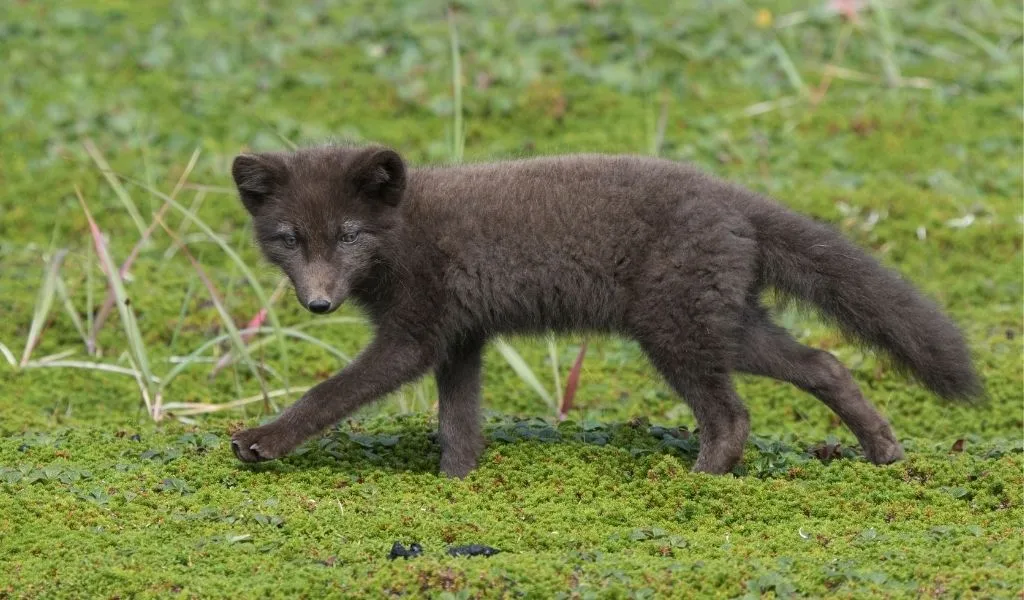When you think of an arctic fox, your mind will likely jump to the white fox with its thick winter coat. However, a little-known arctic fox fact is that there is another type called the blue morph arctic fox which is much rarer.
They do not grow a white winter fur coat, tend to favor different habitats and diets to the white fox, and have different reproductive cycles too. Keep reading to find out more about the blue morph.
Can Arctic Foxes Be Blue?
Yes, there are two types of arctic fox; the common white arctic fox and the blue morph arctic fox. Their color is determined by a blue gene which is more dominant than the white one1 (source: Polar Research, Meinke et al, Vol 20, Issue 1, 2001).
Arctic foxes change color with the different seasons which give them camouflage against the changing landscape.
Unlike the white arctic fox, the blue morph does not grow a thick white winter coat, although they do change the pigment of their coat to some extent.
In summer, they have a dark gray/blue coat (often described as charcoal color) which they shed for a slightly lighter gray coat in winter2 (source: Peptides, D.I. Vage et al., Vol 26, 2005).
The below image shows the white acrtic fox on the left and the blue arctic fox on the right. The top images are their summer coat and the bottom images are their winter coat3 (photo credits: Jason Roberts [winter] and Eva Fuglei [summer] in Global Warming and effects on the Arctic Fox).

Similar to the white morph, it is pigments known as melanin that allow the blue arctic fox to change the color of it’s coat with the seasons.
Arctic foxes are not the only animals to exhibit such behavior, there are 21 different species from 5 families of birds and mammals that do this including the arctic hare and lemmings, both of which can be prey for arctic foxes.
Where Are Blue Arctic Foxes Found?
Arctic foxes live above the arctic circle, in the tundra of Alaska, Canada, Greenland, Iceland, Russia, and Scandinavia4 (source: ICUN). They can be divided into two different populations, inland and coastal, which each have different diets and breeding habits.
Both blue and white arctic foxes can be found in both inland and coastal populations. However, blue morph arctic foxes are more common on the coastline than the white arctic fox because their coat provides better camouflage in these areas. The blue morph arctic fox is most common in coastal populations of Greenland and Iceland5 (source: Journal of Animal Ecology, C.D Bernardi, et al, Vol 90, Issue 5, 2021).
The coastal population only represents a small proportion of the total population of arctic foxes and therefore blue morph arctic foxes are much rarer than white ones.
The majority of arctic foxes found inland are the white morph6 (source: Dietary variation in arctic foxes IAIopex lagopusl –
an analysis of stable carbon isotopes, A. Angerbjorn et al, Oecologia Vol 99, 1994) and estimates suggest they could make up as much as 99% of the total arctic fox population7 (source: ICUN, C.Sillero-Zubiri, M. Hoffmann and D.W. Macdonald, 2004).
The camouflage provided by their coat is helpful for both avoiding predators and sneaking up on their prey8 (source: Dynamics of the Arctic Fox Population in Sweden, A. Angerbjorn et al, Annales Zoologici Fennici, Vol 32 Issue 1, 1995). More on the diet of an arctic fox below.
Studies have spotted a correlation between the proportion of blue arctic foxes and the amount of snowfall. When there is more snowfall, this is more favorable to the white foxes who can camouflage better so the blue fox population declines and vice versa9 (source: Polar Research, Meinke et al, Vol 20, Issue 1, 2001).
Are Blue Arctic Foxes Rare?
Yes, blue arctic foxes are rare compared to white arctic foxes, making up around 1% of the total population.
They are mainly found around coastal areas of Greenland, Iceland, and Fennoscandia where their fur coat blends in with the rocky cliffs.
In Iceland, it’s estimated that blue arctic foxes could make up as much as 65-70% of the total arctic fox population and around 25-30% in Fennoscandia10 (source: ICUN, C.Sillero-Zubiri, M. Hoffmann and D.W. Macdonald, 2004).
Blue vs White Arctic Foxes
Blue arctic foxes are mostly found in coastal areas when their diet consists of seabirds, fish, and other marine invertebrate that is washed up by the sea.
This compares to the diet of inland arctic foxes (predominately white) which tends to be small rodents such as lemmings. The inland diet is less stable than the coastal diet as lemming populations fluctuate from year-to-year with large spikes every 3-5 years11 (source: The Biology and Conservation of Wild Canids, D.W. Macdonald and C. Sillero-Zubiri, 2004).
Due to the stable diet found in coastal areas, blue morph arctic foxes are more likely to reproduce a small litter every year whereas the inland white arctic foxes only reproduce in peak lemming years when food is in abundance and are likely to produce a larger litter.
Blue and white arctic foxes do reproduce together. Blue arctic foxes have a better infant survival rate in colder climates whereas white arctic foxes have a better survival rate in warmer climates. However, this isn’t related to the color of their fur and is likely due to adaptations and behavioral traits they have developed over time12 (source: Journal of Animal Ecology, C.D Bernardi, et al, Vol 90, Issue 5, 2021).
Do Blue Arctic Foxes Migrate?
No, most arctic foxes do not migrate because they are well adapted to live in the tundra year-round. However, when food is in short supply, they will often take short commuter trips to nearby sea ice where they will feed off the seal carcasses left behind by polar bears.
Studies in Greenland suggest that blue arctic foxes are more stationary as the food supply in coastal areas where they are found is more stable throughout the year13 (source: Polar Research, Meinke et al, Vol 20, Issue 1, 2001).
However, a small proportion of arctic foxes are known to migrate (less than 5%). An example of a blue morph arctic fox migrating was tracked in detail back in 2017. The fox migrated 3,500km from Norway to Canada in just 76 days, using moving sea ice as a way of getting between continents14 (source: The Guardian).
Related Questions
Are There Other Types of Arctic Fox?
The main color morphs of the arctic fox are white and blue. Some sources suggest there is a third sandy morph of arctic fox that is even rarer15 (source: animalecologyinfocus.com), however, there is little evidence of this in research papers.





